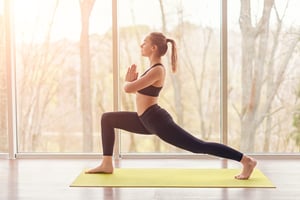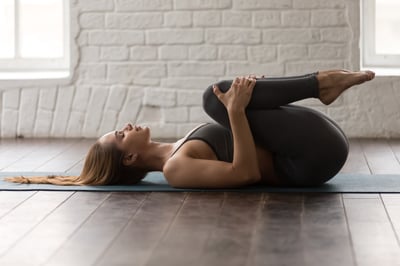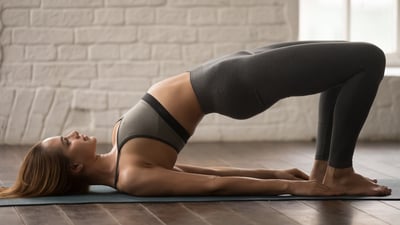 Although some sciatica sufferers require surgery to achieve lasting pain relief, others see success with more conservative nonsurgical treatment options. In up to 85 percent of patients1, symptoms may resolve with nonsurgical treatments, including proper exercise therapy.
Although some sciatica sufferers require surgery to achieve lasting pain relief, others see success with more conservative nonsurgical treatment options. In up to 85 percent of patients1, symptoms may resolve with nonsurgical treatments, including proper exercise therapy.
Your doctor will likely recommend nonsurgical treatments such as these before moving forward with surgery for sciatica. For instance, certain yoga poses are a great example of an effective, low-impact way to manage your symptoms and relieve your lower back and leg pain.
4 Effective Yoga Poses for Sciatica Relief
Stretching programs like yoga and pilates can improve strength and flexibility in the lumbar spine, effectively relieving painful symptoms caused by a herniated disc. The following yoga poses are viewed by medical professionals at Spine-Health2 as safe and effective for sciatica pain relief:

1. Knees-to-Chest Pose
Knees-to-chest pose helps to stretch out tense muscles in the lower back, as well as the piriformis muscle located in the buttocks, which is also known to aggravate the sciatic nerve. To perform knees-to-chest pose:
- Lie flat on your back with your legs straight and the back of your legs touching the ground. Inhale.
- As you exhale, bring your thighs up to your chest by bending your knees.
- Wrap your arms around your knees, keeping your back flat against the ground.
- Hold this position for 30-60 seconds. Breathe slowly and deeply.
- While exhaling, you can gently release your legs back to their original position.
- Repeat up to five times or as often as you are comfortable.
- A modified version of this pose can also be performed by keeping one leg straight and bringing only a single knee to the chest. If so, alternate this method with both legs.

2. Cobra Pose
Cobra pose works out the core muscles and stretches the lower back. To perform cobra pose:
- Lie flat on your stomach with your legs straight.
- On the ground next to your ribcage, place your palms flat. Keep your elbows tucked in close to your body.
- As you inhale, push with your arms and lift your chest off of the ground, keeping your eye gaze straight ahead or gently tilting your head back if the neck allows.
- Keep your back arched, with your hips and lower body pressed to the ground.
- Hold this position for 10-20 seconds, taking slow, deep breaths.
- Gently lower your torso to the ground and repeat 2-3 times.
- If standard cobra pose proves painful or difficult, you can come into sphinx pose by placing your forearms on the ground, and positioning your elbows directly under your shoulders.

3. Bridge Pose
Bridge pose helps strengthen the muscles in the lower back, and thighs. To perform bridge pose:
- Lie flat on your back with both knees bent, keeping your arms straight at your sides with your feet and palms flat on the floor. Your fingertips should be able to graze your ankles, ensuring proper alignment.
- Inhale and slowly raise your hips in the air, attempting to create a straight line from your knees to your hips and shoulders.
- Hold this pose for five seconds, exhale, and slowly lower your hips to the ground.
- Repeat this process five times, or as often as you are comfortable.

4. Cat-Cow Pose
Cat-cow pose (also called the cat-dog pose) improves the forward and backward bending of the lower back, as well as your spinal flexibility, posture, and balance. To perform cat-cow pose:
- Get down on all fours with your knees and hands on the floor and your back and neck in a straight, neutral position. Your wrists should be aligned under your shoulders and knees aligned under your hips.Inhale and slowly tighten your abdomen, rounding your back towards the ceiling and bringing your eye gaze back toward your navel.
- Exhale and arch your lower back, gently lifting the eye gaze toward the ceiling and pointing your tailbone out. Repeat 5-10 times or as often as you are comfortable.
When performing yoga for sciatica, it’s important to maintain proper posture, avoid bending forward or twisting at the waist (particularly when standing), and pay attention to your body’s response. If a particular pose is more painful or uncomfortable than others, you’ll likely want to avoid that position moving forward. Avoid hamstring stretches, which can actually further aggravate your sciatica symptoms.
Other Sciatica Treatments You Can Try at Home
Your doctor may recommend specific yoga poses or other light exercises and stretches to reduce your sciatica symptoms, such as cycling, walking, or swimming. Additional steps you can take to manage sciatica symptoms include:
- Strengthening and developing your core
- Engaging in low-impact exercise
- Being aware of important risk factors
- Treating pain over-the-counter
- Using hot and cold therapies
- Laying in the “psoas” position
There’s no question sciatica can be a painful and frustrating condition for countless individuals. However, with the right exercise techniques and lifestyle changes, you can effectively minimize your sciatica symptoms and get back to your normal routine. Unfortunately, some cases can be too severe for at-home exercises to relieve. For these cases, surgery may be the best option to get the needed relief. If your physician recommends a discectomy surgery, Barricaid is an implant intended to close holes in your disc and prevent reherniation.
While this blog is meant to provide you with information you need to make an informed decision about your treatment options, it is not intended to replace professional medical care or provide medical advice. If you have any questions about Barricaid, please call or see your doctor, who is the only one qualified to diagnose and treat your spinal condition. As with any surgical procedure, you should select a doctor who is experienced in performing the specific surgery that you are considering.
If you have any questions about the Barricaid device, you may ask your doctor. For additional information, please visit www.barricaid.com. For complete risk-benefit information: www.barricaid.com/instructions-for-use.
References
1 Alexander M. Dydyk et al, “Disc Herniation,” StatPearls, StatPearls Publishing, 2020, https://www.ncbi.nlm.nih.gov/books/NBK441822.
2 Darren Riccio, “Best Yoga Poses for Sciatica Relief,” Spine Health, Veritas Health, May 2020, https://www.spine-health.com/blog/best-yoga-poses-sciatica-relief.


Comments